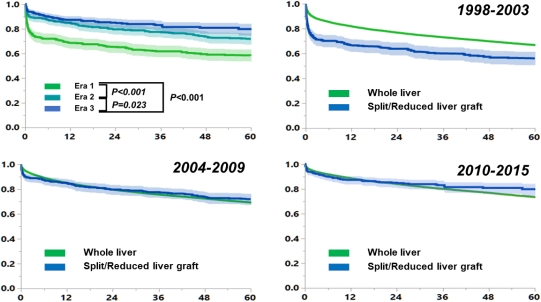Split/Reduced Liver Grafts in Adult Liver Transplantation, No Longer a Risk for Graft Loss
General Surgery, Cleveland Clinic, Cleveland, OH.
Meeting: 2018 American Transplant Congress
Abstract number: 550
Keywords: Split-liver transplantation
Session Information
Session Name: Concurrent Session: Liver: Living Donors and Partial Grafts
Session Type: Concurrent Session
Date: Tuesday, June 5, 2018
Session Time: 4:30pm-6:00pm
 Presentation Time: 4:30pm-4:42pm
Presentation Time: 4:30pm-4:42pm
Location: Room 608/609
Objective:Split/reduced graft liver transplantation(SRLT), while widely accepted in pediatrics, remains underutilized in adults. SRLT is considered a negative factor for graft quality(HR;1.52) in liver donor risk index reported by Feng et al. in 2006. This study aimed to investigate whether improved donor-recipient matching and accumulated technical advancements had improved SRLT outcomes
Methods:This study used 82,554 adult patients in the scientific registry of transplant recipients(SRTR) from 1998-2015, evaluating characteristics and outcomes of 1,221(1.5%) SRLT patients according to time periods(Era1;1998-2003, Era2;2004-2009, Era3;2010-2015). Cox proportional hazards models for overall graft survival and the Kaplan-Meier method were used to assess prognostic outcomes. P<0.05 was defined as statistical significance
Results:The case number of SRLT remained 60 cases/year over the study period and each time period(Era1;408, Era2;402, and Era3;411 cases). 102 centers performed at least one case. More than half the cases were performed by 12 high volume centers; each performed at least 30 cases (53.4%, 652/1221). Over the study period, the median donor age was less in Era2(20, IQR16-28) and Era3(21, IQR16-29) than Era1(22, IQR17-33)(P<0.001). On the other hand, recipient age was greater in Era2(54.5, IQR48-61) and Era3(58, IQR51-63) than Era1(51, IQR45-57)(P<0.001). The cold ischemic time in Era3 was shorter than the other two groups(7.3 hours vs 8 hours and 8 hours; P<0.001). The length of stay has significantly improved over time(from 13days to 10day, P<0.001). 1 and 5-year graft survival also improved over time; 68.6 and 58.3%, 84.8 and 71.9%, and 87.3 and 79.8% in Era1, Era2 and Era3, respectively(P<0.001). The adjusted HR of SRLT was significantly more hazardous than whole grafts in Era1(HR;1.39, P<0.001); however, no significant difference remained in Era2 and Era3(HR;1.04 and 0.94, respectively)
Conclusions: The accumulated experience has improved SRLT outcomes and the split/reduced liver graft is no more hazardous than whole liver grafts.
CITATION INFORMATION: Sasaki K., Firl D., McVey J., Iuppa G., Fujiki M., Diago Uso T., Aucejo F., Eghtesad B., Quintini C., Miller C., Hashimoto K. Split/Reduced Liver Grafts in Adult Liver Transplantation, No Longer a Risk for Graft Loss Am J Transplant. 2017;17 (suppl 3).
To cite this abstract in AMA style:
Sasaki K, Firl D, McVey J, Iuppa G, Fujiki M, Uso TDiago, Aucejo F, Eghtesad B, Quintini C, Miller C, Hashimoto K. Split/Reduced Liver Grafts in Adult Liver Transplantation, No Longer a Risk for Graft Loss [abstract]. https://atcmeetingabstracts.com/abstract/split-reduced-liver-grafts-in-adult-liver-transplantation-no-longer-a-risk-for-graft-loss/. Accessed December 25, 2025.« Back to 2018 American Transplant Congress
